Pixel Buds 2a level up with Active Noise Cancellation Google just wrapped up what might be their most ambitious hardware showcase in years, and this wasn't your typical "here's a slightly better phone" presentation — we're talking about a full ecosystem refresh. There were new Pixel phones that come with better cameras, a whole new chip, and more AI than ever. Oh wait, there's Pixelsnap too. Phones weren't the only thing new — Google also brought in a new Pixel Watch, a more affordable pair of Pixel Buds, new features for their existing Buds, all with a whole lot of AI sprinkled throughout.
With the event now over, here's a roundup of everything Google announced at this year’s "Made by Google" showcase.
Tensor G5 is Google's biggest silicon upgrade yet
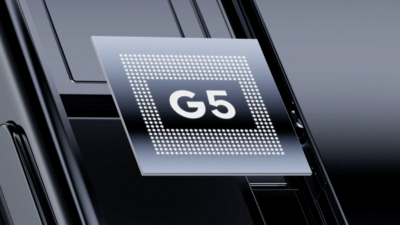
The biggest of all announcements has to be Google's new chip, the Tensor G5 — its biggest silicon upgrade since the original Tensor launched. Built on TSMC's 3nm process node and co-designed with Google DeepMind, this isn't just about raw performance, though the 60% more powerful TPU and 34% faster CPU certainly don't hurt. The real story is how Tensor G5 enables genuinely useful on-device AI that actually works smoothly in daily use.
The chip is the first to run Google's newest Gemini Nano model, which processes AI tasks 2.6x faster and 2x more efficiently than previous generations. This means features like Magic Cue, Voice Translate, and enhanced camera processing happen right on your phone without cloud dependence. Google's also built a completely new Image Signal Processor that handles everything from 10-bit video recording to 100x Pro Res Zoom, proving they're serious about making Pixel cameras genuinely competitive.
What's impressive is that despite all this AI horsepower, Tensor G5 actually helps extend battery life to 30+ hours across the Pixel 10 lineup.
The Pixel 10 gets the upgrades it deserved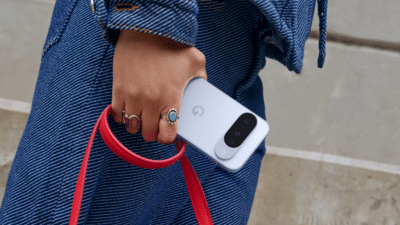
The regular Pixel phone is finally getting some serious love. Google's done something smart here by giving the vanilla Pixel 10 a proper telephoto lens with 5x optical zoom and 20x Super Res Zoom. That's huge, because zoom capabilities used to be the thing that separated the regular folks from the Pro buyers.
The specs tell a similar story. We're looking at 12GB of RAM and Google's new Tensor G5 chip, which they're claiming delivers 34% faster performance and 60% better AI processing. Battery life promises 30+ hours with fast charging that gets you to 55% in about half an hour.
The 6.3-inch Actua display hits 3,000 nits peak brightness, which means you can actually see the thing outdoors without squinting like you're staring into the sun.
The camera setup is particularly interesting — you get the main 48MP shooter with Google's signature HDR+ magic, an ultra-wide for those group shots where someone's always getting cut off, and now that telephoto lens that was missing before.
They're also doing something fun with colours this time around. Instead of the usual "here's black and white, maybe we'll throw in blue," we're getting Obsidian, Indigo, Frost, and Lemongrass.
All that starting at Rs 79,999 ($799), and is up for pre-orders.
Pixel 10 Pro brings serious camera upgrades to the table
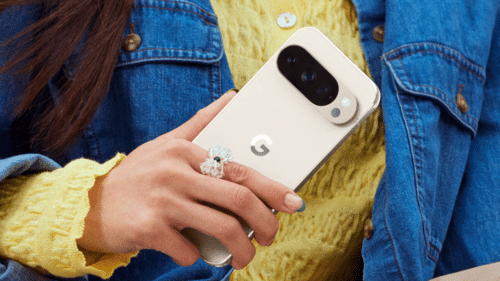
Now this is where Google flexes their engineering muscles. The Pro models are packing 100x Pro Res Zoom, which sounds like one of those marketing numbers that means nothing until you actually try it. The secret sauce is an upgraded 5x telephoto working with that new Tensor G5 imaging processor.
But here's where it gets interesting — they've built something called Camera Coach right into the camera app. It uses Gemini AI to analyse what you're shooting and suggests better angles, lighting, and settings. It can even recommend compositions you might not have thought of. Whether that's helpful or annoying probably depends on how good you think you are at taking photos already.
Auto Best Take is solving a real problem though. You know how group photos always have that one person blinking or looking weird? This thing automatically finds similar shots and combines them so everyone looks good. They've also improved Add Me, which lets you add yourself to group photos even when you're the one behind the camera.
The display cranks up to 3,300 nits peak brightness — genuinely impressive stuff. Both the 6.3-inch and 6.8-inch models have identical specs, including 16GB of RAM that feels like overkill today but might be prescient as AI gets more demanding. You're choosing based on size preference, not feature compromises.
Pro buyers get a year of Google AI Pro thrown in, including access to their video generation tools and enhanced productivity features. Whether that's worth it depends on how much you care about creating AI videos of your cat.
The Pixel 10 Pro, Pixel 10 Pro XL are also up for preorders, and comes starting at Rs 1,09,000.
Pixel 10 Pro Fold tackles the durability question
Google's taking another swing at foldables, and this time they seem to have learned from the category's growing pains. The big news is IP68 water resistance — a first for any Pixel Fold. They've also engineered a gearless hinge that's supposedly good for 10+ years of folding, which addresses the "will this thing fall apart" concerns that plague expensive foldables.
The screens are where things get interesting. The inner 8-inch display uses ultra-thin glass with dual layers of protection film, while the outer 6.4-inch screen maintains that normal phone feel. Brightness improvements hit 3,000 nits peak, making outdoor use actually practical.
The software experience is where foldables either justify their existence or don't. Google's split-screen multitasking feels more natural now, and the drag-and-drop between apps creates workflows that are genuinely faster than jumping between phone apps. Planning a trip by comparing flights in one window while checking hotels in another actually makes sense.
Pixel 10 Pro Fold costs Rs 1,72,999, and you'd be able to buy in the coming weeks.
Camera features like Dual Screen Preview let everyone see themselves while posing, and tabletop mode enables hands-free astrophotography. There's even a Made You Look feature that shows animations to get kids' attention for photos. Google's clearly thinking about why someone would want a foldable beyond just "bigger screen for videos."
Pixelsnap brings magnetic accessories to Android
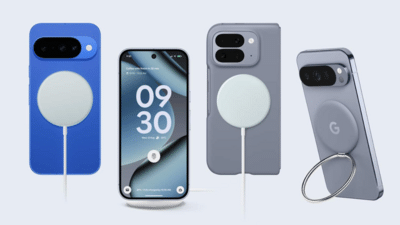
Here's the surprise announcement — if you haven't been on the internet for last few weeks — Google's magnetic accessory system called Pixelsnap, built into all Pixel 10 devices. It enables wireless chargers, stands, grips, and third-party accessories to snap on magnetically, even through cases.
The Pixelsnap Charger delivers 25W Qi2 wireless charging with modular design that lets you detach pieces for portability. There's also a version with an adjustable stand for hands-free viewing while charging. Google's partnering with third-party manufacturers for certified accessories, suggesting they're serious about building an ecosystem.
Whether this takes off depends on pricing and accessory availability. Google's track record with hardware ecosystems is mixed, but the magnetic approach feels more intuitive than previous proprietary attempts.
Magic Cue promises contextual AI on Pixel phones that actually helps
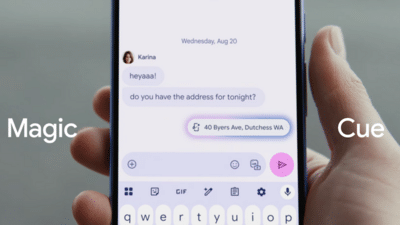
Magic Cue is Google's shot at proactive AI assistance that anticipates what you need based on context. Call your airline and flight details surface automatically. Friend asks for your Airbnb address and the info appears ready to share. It's powered by on-device processing, so your personal stuff stays private while enabling helpful features.
The examples sound useful, but predictive features live or die on accuracy. Get it right and it feels like magic. Get it wrong and it becomes annoying digital noise. Google's betting their contextual understanding has reached the point where this works more often than it doesn't.
Pixel Watch 4 gets better, brighter, and more AI

The fourth-generation Pixel Watch isn't revolutionary, but it's addressing the right problems. The display is 50% brighter with smaller bezels, which makes outdoor readability dramatically better. Anyone who's tried to check their watch in bright sunlight knows this matters more than fancy new sensors.
The new chip architecture promises better performance while extending battery life — crucial for something you're supposed to wear all day. Dual-band GPS provides more accurate tracking, and they've made the design serviceable, which is good news for long-term ownership and sustainability.
Health monitoring gets AI-powered insights that adapt to your patterns, and smart replies powered by on-device processing could actually improve how you interact with notifications. The 41mm and 45mm size options mean you're not stuck with one-size-fits-nobody approach.
Pixel Buds 2a level up with Active Noise Cancellation

The Pixel Buds 2a bring Active Noise Cancellation to the A-Series line for the first time, along with 7 hours of playback extending to 20 hours with the case.
The twist-to-adjust stabiliser is clever — customise the fit for workouts or casual listening. Powered by the Tensor A1 chip, they promise premium audio processing and AI features typically reserved for higher-end models.
Pixel Buds Pro 2 get significant software updates including Adaptive Audio that automatically adjusts to your environment and Loud Noise Protection for hearing safety. You can accept or decline calls by nodding or shaking your head, which feels futuristic even if the practical utility remains to be seen.
Both models integrate with Gemini for hands-free AI interaction, though the quality depends on noise cancellation effectiveness and voice recognition accuracy in real-world conditions.
Google's hardware vision finally comes together
After a decade of feeling like they were playing catch-up, Google seems to have finally landed on a coherent hardware strategy that actually makes sense, and that as usual has a lot of AI sprinkled wherever Google can. Now, whether consumers actually want the AI-powered future Google's building remains the big question, but at least now they're backing it with hardware that can compete on specs and features.
With the event now over, here's a roundup of everything Google announced at this year’s "Made by Google" showcase.
Tensor G5 is Google's biggest silicon upgrade yet
The biggest of all announcements has to be Google's new chip, the Tensor G5 — its biggest silicon upgrade since the original Tensor launched. Built on TSMC's 3nm process node and co-designed with Google DeepMind, this isn't just about raw performance, though the 60% more powerful TPU and 34% faster CPU certainly don't hurt. The real story is how Tensor G5 enables genuinely useful on-device AI that actually works smoothly in daily use.
The chip is the first to run Google's newest Gemini Nano model, which processes AI tasks 2.6x faster and 2x more efficiently than previous generations. This means features like Magic Cue, Voice Translate, and enhanced camera processing happen right on your phone without cloud dependence. Google's also built a completely new Image Signal Processor that handles everything from 10-bit video recording to 100x Pro Res Zoom, proving they're serious about making Pixel cameras genuinely competitive.
What's impressive is that despite all this AI horsepower, Tensor G5 actually helps extend battery life to 30+ hours across the Pixel 10 lineup.
The Pixel 10 gets the upgrades it deserved
The regular Pixel phone is finally getting some serious love. Google's done something smart here by giving the vanilla Pixel 10 a proper telephoto lens with 5x optical zoom and 20x Super Res Zoom. That's huge, because zoom capabilities used to be the thing that separated the regular folks from the Pro buyers.
The specs tell a similar story. We're looking at 12GB of RAM and Google's new Tensor G5 chip, which they're claiming delivers 34% faster performance and 60% better AI processing. Battery life promises 30+ hours with fast charging that gets you to 55% in about half an hour.
The 6.3-inch Actua display hits 3,000 nits peak brightness, which means you can actually see the thing outdoors without squinting like you're staring into the sun.
The camera setup is particularly interesting — you get the main 48MP shooter with Google's signature HDR+ magic, an ultra-wide for those group shots where someone's always getting cut off, and now that telephoto lens that was missing before.
They're also doing something fun with colours this time around. Instead of the usual "here's black and white, maybe we'll throw in blue," we're getting Obsidian, Indigo, Frost, and Lemongrass.
All that starting at Rs 79,999 ($799), and is up for pre-orders.
Pixel 10 Pro brings serious camera upgrades to the table
Now this is where Google flexes their engineering muscles. The Pro models are packing 100x Pro Res Zoom, which sounds like one of those marketing numbers that means nothing until you actually try it. The secret sauce is an upgraded 5x telephoto working with that new Tensor G5 imaging processor.
But here's where it gets interesting — they've built something called Camera Coach right into the camera app. It uses Gemini AI to analyse what you're shooting and suggests better angles, lighting, and settings. It can even recommend compositions you might not have thought of. Whether that's helpful or annoying probably depends on how good you think you are at taking photos already.
Auto Best Take is solving a real problem though. You know how group photos always have that one person blinking or looking weird? This thing automatically finds similar shots and combines them so everyone looks good. They've also improved Add Me, which lets you add yourself to group photos even when you're the one behind the camera.
The display cranks up to 3,300 nits peak brightness — genuinely impressive stuff. Both the 6.3-inch and 6.8-inch models have identical specs, including 16GB of RAM that feels like overkill today but might be prescient as AI gets more demanding. You're choosing based on size preference, not feature compromises.
Pro buyers get a year of Google AI Pro thrown in, including access to their video generation tools and enhanced productivity features. Whether that's worth it depends on how much you care about creating AI videos of your cat.
The Pixel 10 Pro, Pixel 10 Pro XL are also up for preorders, and comes starting at Rs 1,09,000.
Pixel 10 Pro Fold tackles the durability question

Google's taking another swing at foldables, and this time they seem to have learned from the category's growing pains. The big news is IP68 water resistance — a first for any Pixel Fold. They've also engineered a gearless hinge that's supposedly good for 10+ years of folding, which addresses the "will this thing fall apart" concerns that plague expensive foldables.
The screens are where things get interesting. The inner 8-inch display uses ultra-thin glass with dual layers of protection film, while the outer 6.4-inch screen maintains that normal phone feel. Brightness improvements hit 3,000 nits peak, making outdoor use actually practical.
The software experience is where foldables either justify their existence or don't. Google's split-screen multitasking feels more natural now, and the drag-and-drop between apps creates workflows that are genuinely faster than jumping between phone apps. Planning a trip by comparing flights in one window while checking hotels in another actually makes sense.
Pixel 10 Pro Fold costs Rs 1,72,999, and you'd be able to buy in the coming weeks.
Camera features like Dual Screen Preview let everyone see themselves while posing, and tabletop mode enables hands-free astrophotography. There's even a Made You Look feature that shows animations to get kids' attention for photos. Google's clearly thinking about why someone would want a foldable beyond just "bigger screen for videos."
Pixelsnap brings magnetic accessories to Android
Here's the surprise announcement — if you haven't been on the internet for last few weeks — Google's magnetic accessory system called Pixelsnap, built into all Pixel 10 devices. It enables wireless chargers, stands, grips, and third-party accessories to snap on magnetically, even through cases.
The Pixelsnap Charger delivers 25W Qi2 wireless charging with modular design that lets you detach pieces for portability. There's also a version with an adjustable stand for hands-free viewing while charging. Google's partnering with third-party manufacturers for certified accessories, suggesting they're serious about building an ecosystem.
Whether this takes off depends on pricing and accessory availability. Google's track record with hardware ecosystems is mixed, but the magnetic approach feels more intuitive than previous proprietary attempts.
Magic Cue promises contextual AI on Pixel phones that actually helps
Magic Cue is Google's shot at proactive AI assistance that anticipates what you need based on context. Call your airline and flight details surface automatically. Friend asks for your Airbnb address and the info appears ready to share. It's powered by on-device processing, so your personal stuff stays private while enabling helpful features.
The examples sound useful, but predictive features live or die on accuracy. Get it right and it feels like magic. Get it wrong and it becomes annoying digital noise. Google's betting their contextual understanding has reached the point where this works more often than it doesn't.
Pixel Watch 4 gets better, brighter, and more AI

The fourth-generation Pixel Watch isn't revolutionary, but it's addressing the right problems. The display is 50% brighter with smaller bezels, which makes outdoor readability dramatically better. Anyone who's tried to check their watch in bright sunlight knows this matters more than fancy new sensors.
The new chip architecture promises better performance while extending battery life — crucial for something you're supposed to wear all day. Dual-band GPS provides more accurate tracking, and they've made the design serviceable, which is good news for long-term ownership and sustainability.
Health monitoring gets AI-powered insights that adapt to your patterns, and smart replies powered by on-device processing could actually improve how you interact with notifications. The 41mm and 45mm size options mean you're not stuck with one-size-fits-nobody approach.
Pixel Buds 2a level up with Active Noise Cancellation
The Pixel Buds 2a bring Active Noise Cancellation to the A-Series line for the first time, along with 7 hours of playback extending to 20 hours with the case.
The twist-to-adjust stabiliser is clever — customise the fit for workouts or casual listening. Powered by the Tensor A1 chip, they promise premium audio processing and AI features typically reserved for higher-end models.
Pixel Buds Pro 2 get significant software updates including Adaptive Audio that automatically adjusts to your environment and Loud Noise Protection for hearing safety. You can accept or decline calls by nodding or shaking your head, which feels futuristic even if the practical utility remains to be seen.
Both models integrate with Gemini for hands-free AI interaction, though the quality depends on noise cancellation effectiveness and voice recognition accuracy in real-world conditions.
Google's hardware vision finally comes together
After a decade of feeling like they were playing catch-up, Google seems to have finally landed on a coherent hardware strategy that actually makes sense, and that as usual has a lot of AI sprinkled wherever Google can. Now, whether consumers actually want the AI-powered future Google's building remains the big question, but at least now they're backing it with hardware that can compete on specs and features.
You may also like

Emmerdale Moira takes brutal revenge after stabbing horror rocks village

UK weather maps show 27 cities to miss out on 30-hour 30C scorcher - full list

Restaurant boasting its own giraffes and zebras is only 40 minutes from major city

Strictly Come Dancing's Ross King' real name unveiled - and why it was changed

'Masterpiece Western like no other' based on a true story now streaming on Netflix







